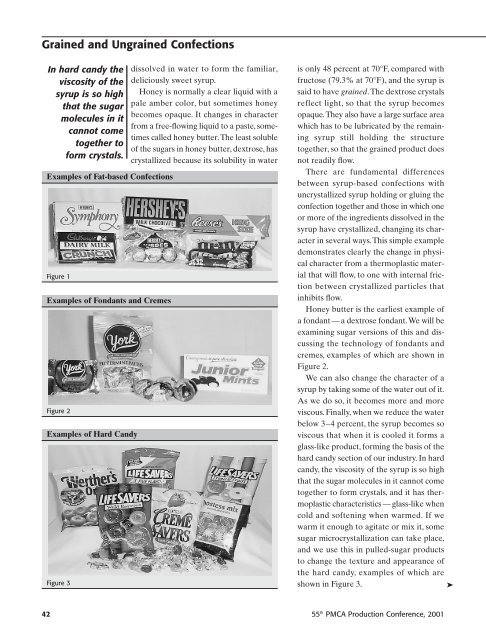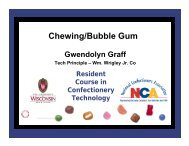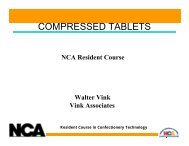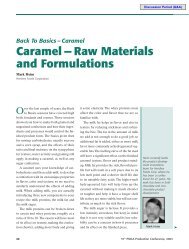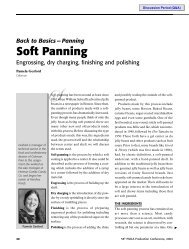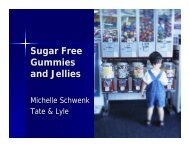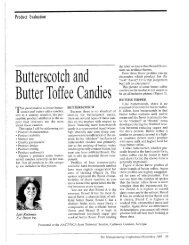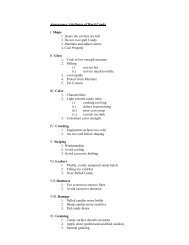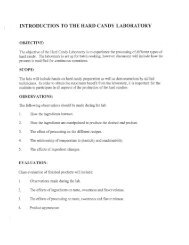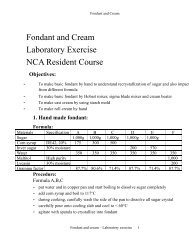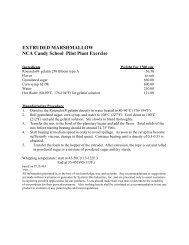2001 Grained and Ungrained Confections - staging.files.cms.plus.com
2001 Grained and Ungrained Confections - staging.files.cms.plus.com
2001 Grained and Ungrained Confections - staging.files.cms.plus.com
You also want an ePaper? Increase the reach of your titles
YUMPU automatically turns print PDFs into web optimized ePapers that Google loves.
<strong>Grained</strong> <strong>and</strong> <strong>Ungrained</strong> <strong>Confections</strong><br />
In hard c<strong>and</strong>y the<br />
viscosity of the<br />
syrup is so high<br />
that the sugar<br />
molecules in it<br />
cannot <strong>com</strong>e<br />
together to<br />
form crystals.<br />
Examples of Fat-based <strong>Confections</strong><br />
Figure 1<br />
Examples of Fondants <strong>and</strong> Cremes<br />
Figure 2<br />
Examples of Hard C<strong>and</strong>y<br />
Figure 3<br />
dissolved in water to form the familiar,<br />
deliciously sweet syrup.<br />
Honey is normally a clear liquid with a<br />
pale amber color, but sometimes honey<br />
be<strong>com</strong>es opaque. It changes in character<br />
from a free-flowing liquid to a paste, sometimes<br />
called honey butter.The least soluble<br />
of the sugars in honey butter, dextrose, has<br />
crystallized because its solubility in water<br />
is only 48 percent at 70°F, <strong>com</strong>pared with<br />
fructose (79.3% at 70°F), <strong>and</strong> the syrup is<br />
said to have grained.The dextrose crystals<br />
reflect light, so that the syrup be<strong>com</strong>es<br />
opaque.They also have a large surface area<br />
which has to be lubricated by the remaining<br />
syrup still holding the structure<br />
together, so that the grained product does<br />
not readily flow.<br />
There are fundamental differences<br />
between syrup-based confections with<br />
uncrystallized syrup holding or gluing the<br />
confection together <strong>and</strong> those in which one<br />
or more of the ingredients dissolved in the<br />
syrup have crystallized, changing its character<br />
in several ways.This simple example<br />
demonstrates clearly the change in physical<br />
character from a thermoplastic material<br />
that will flow, to one with internal friction<br />
between crystallized particles that<br />
inhibits flow.<br />
Honey butter is the earliest example of<br />
a fondant — a dextrose fondant.We will be<br />
examining sugar versions of this <strong>and</strong> discussing<br />
the technology of fondants <strong>and</strong><br />
cremes, examples of which are shown in<br />
Figure 2.<br />
We can also change the character of a<br />
syrup by taking some of the water out of it.<br />
As we do so, it be<strong>com</strong>es more <strong>and</strong> more<br />
viscous. Finally, when we reduce the water<br />
below 3–4 percent, the syrup be<strong>com</strong>es so<br />
viscous that when it is cooled it forms a<br />
glass-like product, forming the basis of the<br />
hard c<strong>and</strong>y section of our industry. In hard<br />
c<strong>and</strong>y, the viscosity of the syrup is so high<br />
that the sugar molecules in it cannot <strong>com</strong>e<br />
together to form crystals, <strong>and</strong> it has thermoplastic<br />
characteristics — glass-like when<br />
cold <strong>and</strong> softening when warmed. If we<br />
warm it enough to agitate or mix it, some<br />
sugar microcrystallization can take place,<br />
<strong>and</strong> we use this in pulled-sugar products<br />
to change the texture <strong>and</strong> appearance of<br />
the hard c<strong>and</strong>y, examples of which are<br />
shown in Figure 3.<br />
➤<br />
42 55 th PMCA Production Conference, <strong>2001</strong>


